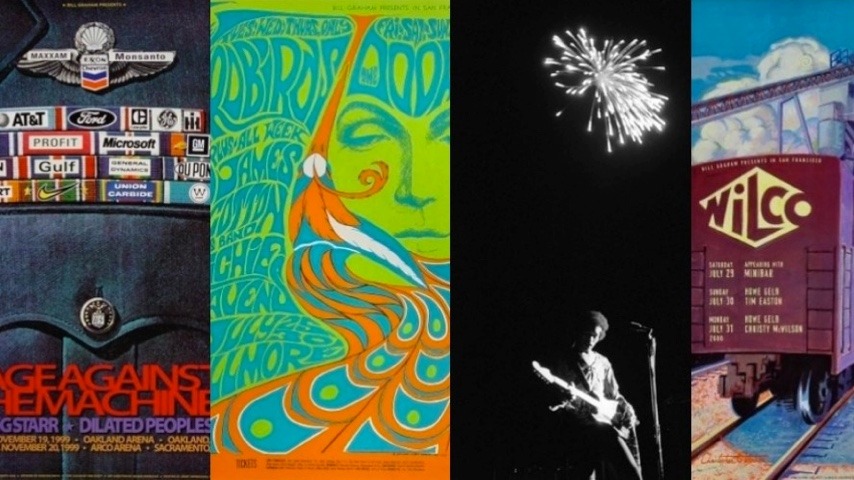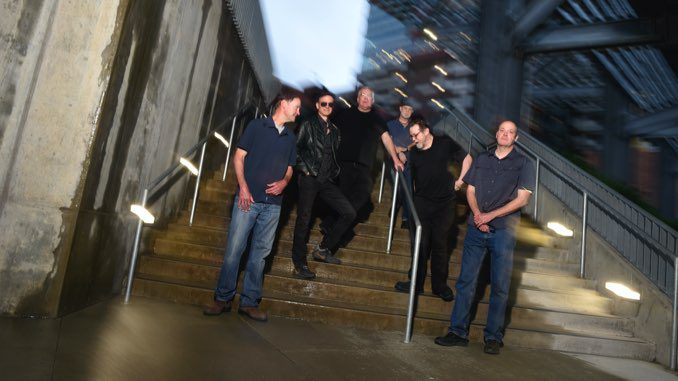Last month, Taylor Swift said, “August slipped away like a bottle of wine,” and boy was she right. Like, does anyone even remember this month? The weeks and months have become more and more indistinguishable throughout the pandemic, but August was an especially hazy 31 days. But, somehow, September is nigh, which means it’s time to reflect on the music we heard this month. August brought us the return of Phil Elverum’s project The Microphones, a wonderful new Bright Eyes album and a surprisingly dynamic release from The Killers. Find all of our favorite albums from August below.
10. The Killers: Imploding The Mirage
Three years after the release of Wonderful, Wonderful, indie rockers The Killers have returned with a new, and arguably great, album called Imploding The Mirage. The album draws back to lead singer Brandon Flowers’ Americana and new wave influences, combined with larger-than-life choruses on singles like “Caution” and “My Own Soul’s Warning,” which sound ready to fill stadiums. Imploding The Mirage also features three collaborations on the album, the most from The Killers on a standard LP, including k.d. lang, Weyes Blood and Fleetwood Mac’s Lindsey Buckingham. The Killers are set to tour the album in Europe next year with Blossoms, Sam Fender and Manic Street Preachers on select dates. Stream The Killers’ Imploding The Mirage here. —Lexi Lane
9. Aminé: Limbo
Charting Aminé’s sonic progression proves to be quite the fulfilling task on his sophomore effort, Limbo. The 26-year-old emcee made major waves in the rap game with his 2017 debut album, Good For You, a playful and adventurous project that showcased not only his lyricism but also his undeniable charisma. Its big breakout single, “Caroline,” was a mirthful infatuation romp that was simply infectious. Although this light-hearted nature dominated Good For You in its entirety, Limbo takes more of an existential turn as Aminé earnestly wonders what comes after that initial rush of success. Opening track “Burden,” with its wailing rhythms and pulsating beat, is what Aminé teases at the beginning as “some shit you go and pick your homey up from jail with.” “Fetus” explores the possibility of fatherhood for a younger Aminé—although it never came to fruition. “Reality,” the album’s final song, brings everything full circle as our protagonist comes to terms with success and all of its proverbial pitfalls. As Aminé delves deep inside himself to excavate his most vulnerable parts, listeners are on the receiving end of a restlessly pensive poet eager to discover the meaning of fulfillment. By no means does Aminé have all of the answers as to what constitutes happiness in a world that prioritizes materialism over people and bragging rights over thoughtful gestures. But he is at least starting to ask the questions, which are inevitable in evolution. —Candace McDuffie
8. Young Jesus: Welcome to Conceptual Beach
Los Angeles-based band Young Jesus have shared their new album, Welcome to Conceptual Beach, via Saddle Creek, which follows 2018’s The Whole Thing Is Just There. They do a lot with just seven tracks—their improvisational jams span jazz, math rock and haunting folk-rock, but nothing is set in stone. It’s blissfully conscious and unconscious, and at times, they sound more like conjurers than musicians. Their abstract, impressionistic lyrics heighten the beautiful recklessness of their music. —Lizzie Manno
7. Bully: SUGAREGG
Bully are one of the most exciting punk bands of the past decade. 2015’s Feels Like and 2017’s Losing didn’t necessarily reinvent anything, but its fuzzy, melodic rock songs were consistently invigorating, with Alicia Bognanno’s raspy voice packing a major punch. Bognanno is behind the boards again for her new record SUGAREGG, but this time she’s joined by a producer for the first time, John Congleton—not the worst choice for your first co-producer! Even after just one spin, it’s clear that Bognanno hasn’t taken her foot off the punk gas pedal. Her third album and second for Sub Pop is empowering, unrelenting and utterly gripping, with a chance of raw explosiveness at any moment. Even the more subtle numbers like “What I Wanted” and “Prism” will leave a cloud of exhaust smoke and tread marks. —Lizzie Manno
6. Samia: The Baby
After a string of hushed ballads and spirited pop/rock tunes, Samia Finnerty (aka Samia) began drawing ears and eyes. The New York-based singer/songwriter’s debut album The Baby centers on her low, rather soulful voice, and it finds her at her most self-assured. Operating in a ’90s and 2000s pop/rock lane, Samia thrives on soaring hooks, which carry even more power thanks to her impressive vocal range. Upbeat rock songs like “Fit N Full” and “Big Wheel” possess yearning and the type of humor that everyone’s craving these days, and they bring instantaneous choruses, too. Her downtempo side is just as moving, if not more so—“Pool” and “Stellate” are packed with desire, with the former embracing a more ethereal pop airiness and the latter leaning into stripped-down, contemplative rock. —Lizzie Manno
5. No Joy: Motherhood
If No Joy’s latest album is a storm, there’s a clear ethos in its eye. In writing and recording the music that would become the band’s first new full-length in five years, frontperson and principal songwriter Jasamine White-Gluz made a conscious effort to emphasize unconventionality, refusing to place limitations on her creative process.
Motherhood is defined by its refusal to compromise—presented with any choice, the album seems to answer, “Why not both?” The result is a creative tornado that sweeps up everything from bongos and trip-hop to slap bass and a broken clarinet, cohering somehow into a set of songs that gives the listener as much as it demands of them. It’s a testament to the power of creativity, intertwined with an emotionally complex contemplation on the act of human creation. That it’s No Joy’s most ambitious album yet, as Paste pointed out in highlighting Motherhood as one of August’s most exciting releases, is not up for debate; that it’s their best is not much more of a discussion. —Scott Russell
4. Ruston Kelly: Shape & Destroy
Shape & Destroy is not the first time Ruston Kelly’s journey has been captured in song. His debut—2018’s Dying Star—showcased his considerable melodic gifts and fearless honesty as it explored Kelly’s trip to and from rock bottom. It’s an album that’s equal parts harrowing and heartening, and it pointed the way for Kelly to deliver on his enormous promise as an artist. Shape & Destroy finds him on the right path, but not yet out of the woods. Nowhere is this more clear than in two back-to-back songs—“Alive” and “Changes”—that examine Kelly’s journey from two very different perspectives. “Looking at the flowers coming up from the ground through all of the rubble of everything that I tore down,” he sings in “Alive,” a slow-burning love song to life (and a supportive partner). One track later, however, he kicks off the strummy, upbeat “Changes” buried in the rubble. “What the hell am I doing down here?” Kelly sings. “I thought that I was finally in the clear. All it takes is once to make your demons reappear.” What a difference a couple of years, hard work, personal reflection and loving, supportive relationships make. Where Dying Star offered only glimmers of hope that Kelly’s garden would someday flourish, Shape & Destroy is a modestly verdant landscape as far as the eye can see—maybe not “tall and purposed” quite yet, but healthy, happy and headed that way. —Ben Salmon
3. Bright Eyes: Down in the Weeds Where the World Once Was
When Bright Eyes announced their first new album since 2011, the media excitedly reported on the band’s reconciliation. But, in reality, Bright Eyes never really broke up. They wandered in different directions, sure, but there were no hard feelings. Gathering to record Down in the Weeds Where the World Once Was was a matter of good timing and schedules aligning. Frontman Conor Oberst suggested the idea for a new record at bandmate Nathaniel Walcott’s Christmas party in 2017, and the pair called the third member of their trio Mike Mogis from the bathroom to pitch the idea. “It was just something we wanted to do for ourselves, because we were all in this stage of our lives…” Oberst says. “Between kids being born and people dying and divorces and people falling in love and all of the crazy amount of life that’s transpired for the three of us, personally… It was just like, what are we going to do? Let’s do the thing we do best. Let’s make a record.” They certainly did some of their best work on Down In The Weeds… The album sounds undeniably like a Bright Eyes record, but it ebbs and flows with new anxieties and darknesses. Fans will delight in a true-to-style Bright Eyes record, but, at the same time, any music fan will be able to appreciate the gruesome grandeur of this folk-rock mastery. —Ellen Johnson
2. Kelly Lee Owens: Inner Song
Dream pop and techno might be vastly different genres, but they share a common goal. Where dream pop’s glimmering, reverb-soaked guitars and keyboards entrance listeners into a listless stupor, techno’s clattering 808s and simple, repetitive rhythms keep the party going. While these modi operandi at first seem diametrically opposed, a closer look reveals that both genres impart enchantment, nirvana, hypnosis and even healing—a night out at the rave is as palliating as an evening splayed out listening to Teen Dream. Welsh songwriter-producer Kelly Lee Owens understands these genres’ powerful overlap more than any other musician in recent memory. With her sophomore album Inner Song, however, Owens potentially opens herself to a much wider audience. A thrilling, dynamic LP that overflows with life, Inner Song is full of dancefloor devotionals that easily rank among her most accessible creations to date. If Kelly Lee Owens gently opened the door between dream pop and techno, Inner Song rushes through it and builds a world where ecstatic, curative, untethered electronic sounds abound. —Max Freedman
1. The Microphones: Microphones in 2020
The last recording released under the Microphones’ name was 2003’s Mount Eerie, a precursor to PhilElverum’s creative shift. The notion that the Microphones disbanded is something of a misconception, because even though he collaborated with other musicians on the project throughout the years, the Microphones name is really synonymous with Elverum himself. Since assuming the Mount Eerie persona, he’s proven incredibly prolific, releasing 10 studio albums under his new name between 2005 and 2019. Elverum slipped back into the Microphones for a performance last summer, and when the stirrings around this choice picked up, he began toying with “what it even means to step back into an old mode.” The result is Microphones in 2020, the sprawling, one-track album lasting nearly 45 minutes. Microphones in 2020 contains some of the year’s best, most reflective and probing lyrics. Elverum’s mastery of language is impressive thanks to his ability to capture an intangible, fleeting feeling without coming across as pretentious or out of reach. It’s honestly worth sitting down and reading the lyrics along with the song, consuming the words as poetry. His descriptions of nature are some of the most soul-stirring moments of the album, which isn’t surprising considering his lifelong sense of unity with the flora and fauna around him. “I started making my own embarrassing early tries at this / thing that sings at night above the house, branches in the wind bending / wordlessly, I wanted to capture it on tape,” he says of his early musical intentions. —Clare Martin




